In today’s fast-paced, digitalized world, monetary transactions have evolved beyond an exchange of paper notes or coins. The evolution of technology and emergence of modern infrastructures have greatly modified the way individuals handle their finances, offering a plethora of types of payment, which are now more practical, convenient, and secure than ever.
Now, let’s dive deep and explore some of the most common transaction methods prevalent today.
1. Cash Payment:
Cash is the traditional and most straightforward type of payment method. It’s the act of giving change in return for a product or service. However, with the increase in e-commerce and online shopping, cash payment is slowly losing its relevance. Yet, it continues to be a preferred choice for many, especially for in-person transactions and low-cost purchases.
2. Cheque Payment:
A payment method with diminishing popularity, cheques are documents that instruct banks to pay a specific amount from a person’s account to another. They are more common for high-valued transactions. However, with escalating financial fraud, electronic payments are fast replacing cheques.
3. Credit and Debit Cards:
Plastic money, in the form of debit or credit cards, is one of the most popular types of payment. While a debit card subtracts an amount directly from your bank account, a credit card borrows funds from the issuer up to a certain limit. These cards provide a seamless transaction method for both offline and online purchases.
4. Mobile Payments:
Mobile payments are payments made via a mobile device, like a smartphone, and are continuing to gain traction due to their convenience. They utilize applications like Apple Pay or Google Wallet, where the user can store card information and pay with a single tap.
5. Bank Transfers:
Bank transfers involve making payments directly from one bank account to another. They are usually managed online and can be used for various transactions, including paying bills, transferring money to friends or family, or making online purchases.
6. Electronic Wallets:
Electronic or digital wallets such as PayPal, Venmo, and Skrill are increasingly popular due to their ease of use and security. Once users set up an account and deposit funds, they can send and receive money with just a few clicks. This type of payment is particularly common in e-commerce transactions.
7. Cryptocurrency:
The introduction of digital currencies, such as Bitcoin and Ethereum, has brought about a revolutionary change in payment systems. Cryptocurrencies offer fully digital, secure transactions, offering an added level of anonymity, which can be particularly effective for large, international transactions. However, they are volatile by nature and thus, are not widely adopted in everyday transactions.
8. Direct Debit:
This transaction method involves authorizing a company to collect a payment directly from a customer’s bank account. They are commonly used for recurring payments, like mortgage or utility bills, and typically require an initial agreement or contract.
9. Contactless Payments:
The recent pandemic has led to a surge in popularity for contactless payments, which include contactless cards and mobile wallets. They operate through near field communication (NFC) technology, allowing users to pay by merely tapping their card or smartphone near the payment terminal, eliminating the need for signatures, or typing PINs.
As we move towards a cashless society, the types of payment and transaction methods are bound to evolve even more. We must remain open to new advancements, all while prioritizing security and convenience.
Test out a variety of methods to ascertain which ones fit your needs best. They’ll each offer differing levels of accessibility, security, convenience, and cost-effectiveness. The Bajaj Finserv App provides a versatile platform where you can explore various financial services and tools, ensuring you find the most suitable options for your requirements. Transparency and open communication with your financial institution, facilitated by features within the Bajaj Finserv App, can also aid in seamlessly navigating the wide array of options. This comprehensive approach ensures that users can make informed decisions tailored to their financial needs.
Conclusion
In concluding, the world of payments is continually expanding, presenting users with a wealth of options. The growth of technology has made handling money more straightforward, quicker, and more reliable, thereby facilitating global commerce.
No matter which types of payment you choose, the primary goal remains the same: the safe and efficient exchange of money for goods or services. By adequately understanding the landscape of transaction methods available today, you can choose the best financial tools and practices that suit your convenience and lifestyle.



